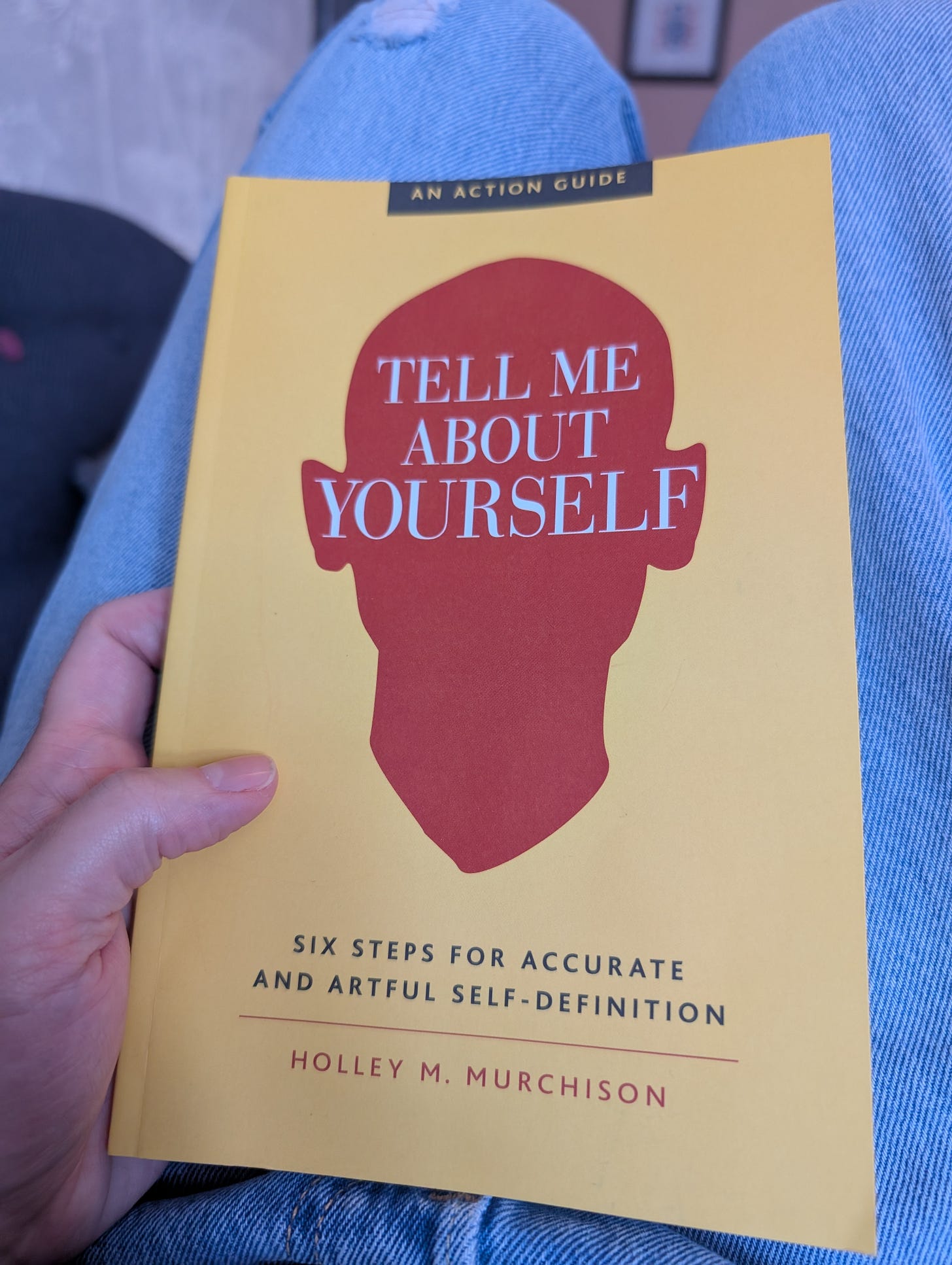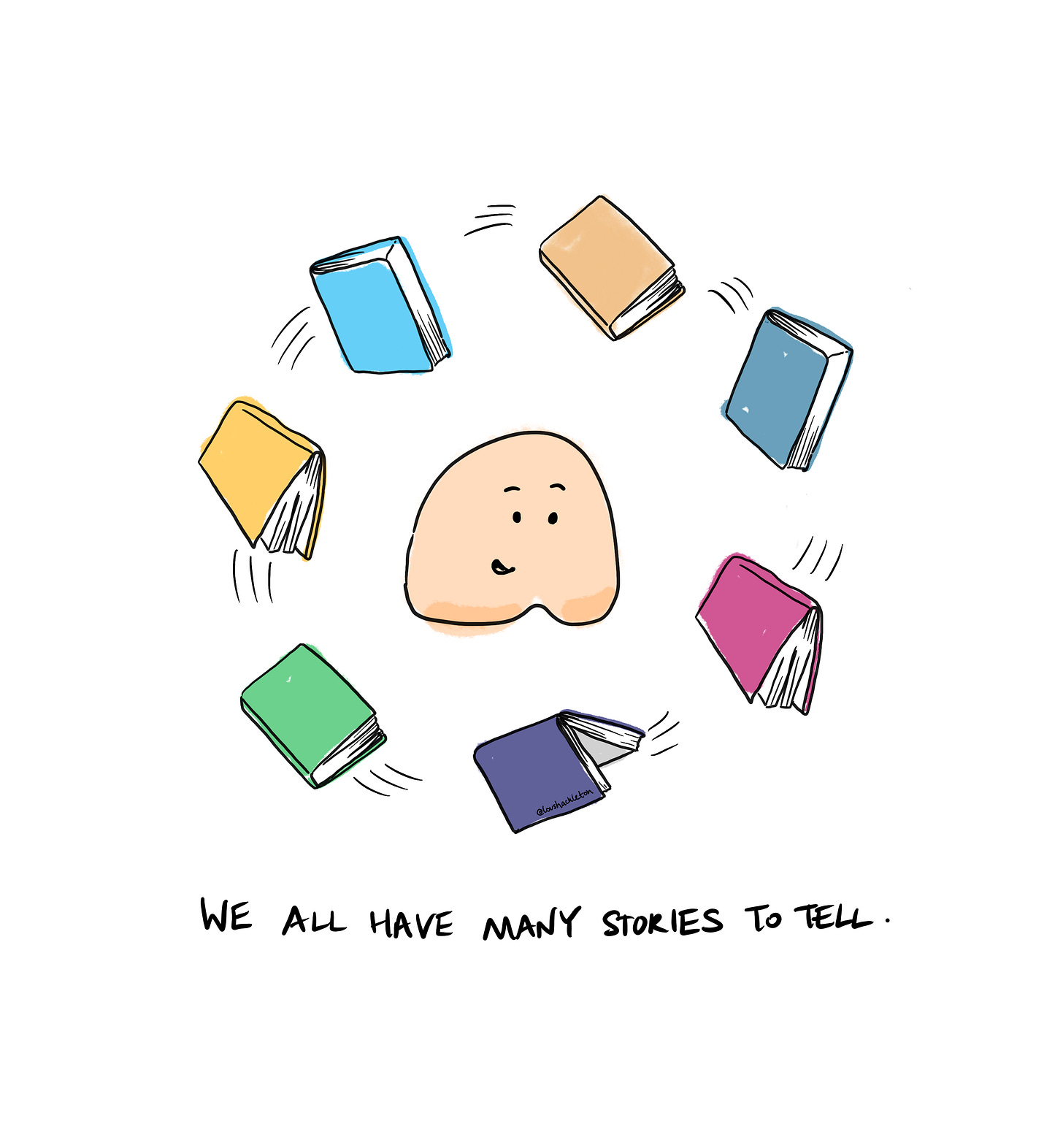Lou Reads... Tell Me About Yourself by Holley M. Murchison
Here's an action guide to the stories that we share when we introduce ourselves, and the power they can hold.
In this edition of Lou Reads, I’m exploring an oldie(ish - 2016) but a goodie, Tell Me About Yourself by Holley M. Murchison. In this book, the author helps us to make the most of the opportunity that is introducing ourselves.
And not in a way that makes us feel like we’re pitching ourselves, but in a way that feels more natural. Where we can tell stories that invite further conversation. Using an introduction as an opportunity for meaningful connection.
The importance of an introduction.
How you talk about yourself is something that is really easily overlooked. In a previous edition of Lou Reads, the one on Transitions by William Bridges, we explored the difference between changes that happen in the external world and the ones that happen in our internal world. We looked at how the changes that happen on the outside set off a chain reaction, and affect the things around them - including our internal world.
Sometimes this change on the inside is so big that we might even have to re-define how we see ourselves completely.
Just like when we have to switch to saying ‘my ex’ instead of ‘my partner’ when a relationship ends. Or when we leave a job and we don’t have that natural, easy-to-access job title to say anymore, when someone asks, ‘what do you do?’
Bridges showed us that what we say about ourselves reflects how we define ourselves and that matters.
And in this new instalment of Lou Reads, I’m presenting a book by Holley M. Murchison that provides a framework to help you to do just that: To be really intentional about what you say about yourself when you introduce yourself. And to have that reflect how you define yourself.
This book can help you to figure out how some of the different aspects of yourself fit together, whilst also providing a framework to follow when you’re asked to introduce yourself. So you can make extra sense of your internal world, and bring to that the external world. It might even result in some changes in your external world.
That’s a pretty good deal!
So, tell me about yourself…?
The book gets you to dig deep into what you say when someone else says, “Tell me about yourself…?” Or if they ask that other common question, “What do you do?”
The author argues that if we can shift the way that we answer those kinds of common questions, it can shift other things too.
In this book, they share their framework for coming up with a short-, medium-, and long- version of your answer.
It’s a framework that leans on the power of storytelling, and provides a way to pull together many different threads of yourself.
I love this approach. Sometimes I feel I need to present a ‘professional’ me, compartmentalised from all the other versions of me. But let’s face it, we’re most likely to want to talk to a multi-faceted human. Being human helps us to break the ice in a way that gives the person we’re talking to a natural next question or response. An invitation to continue the conversation.
That’s something that this book gets us to think about too: Who is actually listening to us when we talk about ourselves? And what is it that they are looking for?
Let’s dive in.
Start with who is listening.
This might sound like the wrong place to start, especially since, so far, I’ve emphasised the way the framework helps you to pull together different threads of yourself, and that it’s focused on telling your story.
But actually, the book begins with choosing the scenario that you’re introducing yourself in, and clarifying who it is that you’re introducing yourself to.
This helps us to see that even though we hear the same question, “Tell me about yourself…”, from many people, the person who is asking it is asking for something more specific.
They’ve got their own perspective, their own agenda, and their own background and interests. And that might be completely different from the next person that asks.
So a big part of your job here is to work out what is going on behind their question. What are they actually asking you? Because if you can figure that out, then you’ll be able to share points that will resonate with the person asking. And will give them opportunities to ask you more.
And that’s what we’re really trying to do with an introduction: start a conversation, not give someone everything they could possibly want to know about you.
Not leaving them confused and not sure what to say next, by not meeting them where they are.
By clarifying the scenario and its audience, you can reframe the question.
You can also be clear on what the other constraints might be, like how long you have to respond. This helps you to come up with an effective response.
Let’s have a look at some examples.
Examples of scenarios might be:
Introducing yourself at a ‘kick off’ team meeting - the first time that team has met.
Being asked to ‘tell me about yourself’ at the start of a job interview.
Going to a family event, seeing a family member you haven’t met in a while, and being asked, ‘What do you do now?’ Or even, with a more familiar member, being asked, ‘How’s work?’
Introducing yourself at the beginning of a talk or podcast episode.
It can also include written content, for example:
Your about page on your website.
Your company bio on your company’s website.
Your instagram bio.
Each of these examples has a slightly different audience and so what that audience actually wants to know is different too.
Reframed questions might be:
What skills do you have that you can bring to the team?
Why should I keep listening to the rest of this talk? Why are you the right person to talk about this topic?
What brought you to apply to this job? What can you tell me about yourself that helps me to see how you might fit into this role (and this team)?
What are you up to these days, and what can you share that will give me more questions to ask - so we can have an interesting conversation?
Can you match these reframed questions to the scenarios I mentioned before?
Having a ‘bowl’ of stories to draw on.
The most significant message of the book is this:
You’re probably not going to end up with the one true bio, the one single story that you tell about yourself, the one that works with everyone all the time.
But, wait. That sounds like a lot of work! You mean I need multiple bios?!?
The beauty of this framework is that it helps you to map out all the ingredients you have to work with, so that you can draw on them at short notice.
You might draw on some more than others, but you’re not going to tell the exact same story every time.
With the ingredients mapped out, you can pick the ones that are best suited to the person in front of you, and their goals and aims.
In this framework, the author is clear on the ingredients:
Your background and interests,
Your values and beliefs,
Your passions, dreams and aspirations,
Your skills and achievements.
This all goes into the bowl.
Then, you use what you know about the scenario, your audience, their actual question, and your own aims to pick out the most relevant parts from the bowl.
Once more, with feeling.
The book also gives you some broad principles to use when pulling your story together in response to your chosen scenario and specific audience. Including practice:
What’s is your aim? Having established the scenario you’re in, the audience in front of you, and the question they’re really asking, what’s most important to you?
Stay focused on your aim. Once you’ve captured it, keep that in mind while you’re planning what to say and while you’re talking.
Keep something back. An introduction is an opening - leave space for your audience to ask something, to seamlessly turn your intro into an interesting conversation.
Use the rule of three (or less). Make three points. Or less. Any more than that, and your listener won’t keep up.
Remember you’re telling a story. Create a narrative that draws your points together.
Practice. You can practice on your own, with your voice recorder, or with colleagues. You can also join my new group programme, Work Your Own Way, for opportunities to practice in a safe, friendly, online session (more on that, below!).
Taking a moment.
When the time comes to introduce yourself in the scenario you’ve been planning for, take a moment:
Five minutes before that team meeting.
Ten minutes on the train on the way to that interview.
A few minutes in the car on the way to that family event.
Create a little summary of bullet points of things that, based on what you know of the audience and their goals, are the ones that you want to make sure you cover, based on how long you know you’ll have.
You only need a short list. The most important things. This helps you to have them front of mind when you’re on the spot.
Join us for more in-depth conversations (and to practice!) in book club?
If you’d like to walk through this framework with a supportive group, consider joining Work Your Own Way as a paid subscriber. Work Your Own Way is a separate group, also hosted on substack, and also run by me.
It means that you can now work with me in a group coaching format.
We’re focused on finding ways to work your own way in your current job or by finding a new one - or in your own business, if you run your own!
Subscribe now to Work Your Own Way and upgrade to get access to:
My breakdown of the exercises from the book featured in this post - and helping you to apply them. Get the most out of this applying this framework to improve how you introduce yourself!
The monthly community calls I host. Take part in group discussions, help each other through the exercises, and ask questions on anything you’re stuck on.
All the posts so far! Covering topics like introducing yourself, the thinking behind the book, an audio meditation and more.
This includes catch up posts with the exercises from our January and February community calls to start as soon as you join!
Practice telling stories about yourself and get extra guidance on choosing your scenario and audience for improving how you introduce yourself.
Homework posts that give you extra insights between calls. Exploring and identifying your personal style and using your current job description to make some changes at work to do more of what you want.
As a paid subscriber, you’d get an invite to our next community call on Friday 28th March at 10am GMT.
You’ll also get every bit of content you can see in our current full plan of activities here - and more as we move through the year.
Come join us!
Read the book yourself.
If you’d like to read the book yourself, here’s the full details:
Murchison, Holley M. (2017). Tell Me About Yourself: Six Steps for Accurate and Artful Self-Definition. Berrett-Koehler Publishers.
Thanks for joining me for this instalment of Lou Reads!











